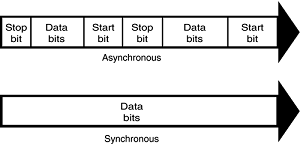Analog Modems
If you want to connect to the Internet without spending a lot of money, an analog modem can serve as your on-ramp to the rest of the computing world. Modems are standard equipment with most recent systems and continue to be popular upgrades for systems that do not have access to broadband solutions, such as two-way cable modem or DSL lines.
Even with some types of broadband access (such as One-way DirecWAY and one-way cable modem), modems are still needed to send page requests and email. The word modem (from modulator/demodulator) basically describes a device that converts the digital data used by computers into analog signals suitable for transmission over a telephone line and converts the analog signals back to digital data at the destination.
To distinguish modems that convert analog and digital signals from other types of access devices, modems are frequently referred to as analog modems; because you must dial a telephone number to reach a remote computer, they are also referred to as dial-up modems.
The typical PC modem is an asynchronous device, meaning it transmits data in an intermittent stream of small packets. The receiving system takes the data in the packets and reassembles it into a form the computer can use. Asynchronous modems transmit each byte of data individually as a separate packet.
One byte equals 8 bits, which, using the standard ASCII codes, is enough data to transmit a single alphanumeric character. For a modem to transmit asynchronously, it must identify the beginning and end of each byte to the receiving modem. It does this by adding a start bit before and after every byte of data, thus using 10 bits to transmit each byte.

For this reason, asynchronous communications have sometimes been referred to as start-stop communications. This is in contrast to synchronous communications, in which a continuous stream of data is transmitted at a steady rate. Synchronous modems generally are used in leased-line environments and in conjunction with multiplexers to communicate between terminals to Unix- or Linux-based servers and mainframe computers.
Thus, this type of modem is outside the scope of this book. Whenever modems are referred to in this book, I will be discussing the asynchronous, analog variety. (Synchronous modems are not found in typical computer stores and aren't included in normal computer configurations, so you might not ever see one unless you go into the data center of a corporation that uses them.)
The use of a single start bit is required in all forms of asynchronous communication, but some protocols use more than one stop bit. To accommodate systems with different protocols, communications software products usually enable you to modify the format of the frame used to transmit each byte.
The standard format used to describe an asynchronous communications format is parity/data bits/stop bits. Almost all asynchronous connections today are therefore abbreviated as N-8-1 (No parity/8 data bits/1 stop bit). The meanings for each of these parameters and their possible variations are as follows:
-
Parity. Before error-correction protocols became standard modem features, a simple parity mechanism was used to provide basic error checking at the software level. Today, this is almost never used, and the value for this parameter is nearly always set to none. Other possible parity values you might see in a communications software package are odd, even, mark, and space.
-
Data Bits. This parameter indicates how many bits are actually carried in the data portion of the packet (exclusive of the start and stop bits). PCs typically use 8 data bits, but some types of computers use a 7-bit byte, and others might call for other data lengths. Communications programs provide this option to prevent a system from confusing a stop bit with a data bit.
-
Stop Bits. This parameter specifies how many stop bits are appended to each byte. PCs typically use 1 stop bit, but other types of protocols might call for the use of 1.5 or 2 stop bits.
In most situations, you will never have to modify these parameters manually, but the controls are almost always provided. In Windows 9x/Me/2000/XP, for example, if you open the Modems control panel and look at the Connection page of your modem's Properties dialog box, you will see Data Bits, Parity, and Stop Bits selectors.
Unless you use the Windows HyperTerminal program to establish a direct connection to another computer via phone lines, you might never need to modify these parameters.
However, if you need to call a mainframe computer to perform terminal emulation for e-banking, checking a library's catalog, or working from home, you might need to adjust these parameters. (Terminal emulation means using software to make your PC keyboard and screen act like a terminal, such as a DEC VT-100 and so on.)
Many mainframe computers use even parity and a 7-bit word length. If your PC is set incorrectly, you'll see garbage text on your monitor instead of the other system's login or welcome screen.